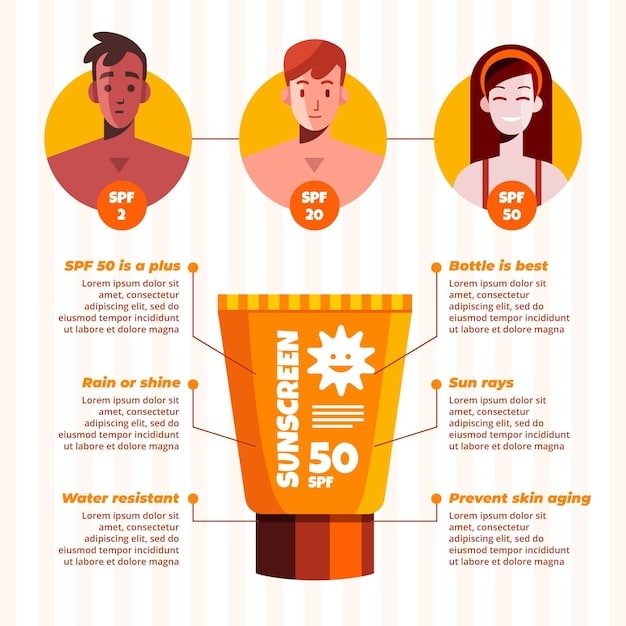The Ultimate Guide to Layering Skincare Products for Maximum Absorption in 2025

Mastering the art of layering skincare products is essential for maximizing their absorption and effectiveness. This ultimate guide provides expert tips and techniques to optimize your skincare routine in 2025, ensuring each product works synergistically for radiant and healthy skin.
Unlocking the full potential of your skincare routine requires more than just applying products; it’s about mastering the art of layering for maximum absorption. Discover the ultimate guide to layering skincare products for maximum absorption in 2025 and transform your skin’s health and radiance.
Why Layering Skincare Matters
Layering skincare products correctly is crucial because it allows each product to penetrate the skin effectively, maximizing its benefits. Understanding the order in which to apply your products can significantly impact their efficacy and overall results.
Enhancing Product Efficacy
Layering enhances the efficacy of skincare products by ensuring each ingredient reaches the appropriate skin layer. Proper layering can also prevent ingredients from counteracting each other, optimizing their individual and combined effects.
Boosting Hydration and Repair
Correctly layered products boost skin hydration and repair by creating a protective barrier and delivering essential nutrients. This approach addresses various skin concerns, from dryness to aging, more effectively than using single products alone.
- Optimize product penetration by starting with the thinnest consistency.
- Prevent product pilling by allowing each layer to absorb fully.
- Target specific skin concerns with products designed for each layer.
- Create a protective barrier against environmental stressors.
In summary, layering skincare enhances product efficacy, boosts hydration, and maximizes repair, leading to healthier and more radiant skin.

The Golden Rule: Thin to Thick
The foundation of successful skincare layering lies in the “thin to thick” rule. This principle ensures that lighter, water-based products are applied first, allowing them to absorb fully before heavier, oil-based products create a protective seal.
Why Consistency Matters
Consistency is key to product absorption. Applying thinner products first allows them to penetrate the skin without being blocked by thicker, heavier formulations. This ensures maximum delivery of active ingredients.
The Science Behind It
The science behind the “thin to thick” rule is rooted in molecular size and skin permeability. Smaller molecules in thinner products can penetrate more easily, while larger molecules in thicker products create a barrier that prevents moisture loss.
- Water-based serums penetrate more effectively when applied first.
- Oil-based products create a barrier to lock in hydration.
- Applying thicker creams first can block the absorption of thinner products.
- Consider the molecular weight of ingredients for optimal layering.
In conclusion, the “thin to thick” rule is crucial for ensuring optimal product absorption and maximizing the benefits of your skincare routine.
Morning Skincare Layering: A Step-by-Step Guide
Your morning skincare routine should focus on protecting your skin from environmental stressors and prepping it for the day. Layering lightweight products that hydrate, protect, and brighten is essential for a fresh and radiant complexion.
Step 1: Cleanser
Start your day with a gentle cleanser to remove impurities and prepare your skin for the products that follow. Choose a cleanser that suits your skin type, whether it’s oily, dry, or sensitive.
Step 2: Toner
Apply a toner to balance your skin’s pH levels and provide a base for better absorption of subsequent products. Look for toners that hydrate and soothe the skin.

Step 3: Serum
Serums are potent treatments packed with antioxidants, vitamins, and other active ingredients. Apply a serum that targets your specific skin concerns, such as vitamin C for brightening or hyaluronic acid for hydration.
Step 4: Moisturizer
Hydration is crucial in the morning. Use a lightweight moisturizer to keep your skin hydrated all day. This also creates a smooth base for makeup
Step 5: Sunscreen
Finally, protect your skin from harmful UV rays with a broad-spectrum sunscreen. Sunscreen is the most important step in any morning skincare routine, preventing premature aging and skin damage.
- Cleanse to remove impurities and prep the skin.
- Tone to balance pH levels and enhance absorption.
- Apply serums to treat specific skin concerns.
- Moisturize for hydration.
- Finish with sunscreen for UV protection.
In short, a morning skincare layered routine should protect the skin from UV rays.
Evening Skincare Layering: Repair and Rejuvenate
Your evening skincare routine is the time to focus on repair and rejuvenation. Layering richer, more nourishing products can help your skin recover from the day’s stressors and promote overnight healing.
Step 1: Double Cleanse
Start with an oil-based cleanser to remove makeup and sunscreen, followed by a water-based cleanser to eliminate any remaining impurities. Double cleansing ensures your skin is thoroughly clean and ready for treatments.
Step 2: Exfoliant (2-3 Times a Week)
Exfoliating 2-3 times a week removes dead skin cells, allowing for better product penetration. Choose a chemical exfoliant like AHA or BHA based on your skin type and concerns.
Step 3: Toner
Use a hydrating toner to rebalance your skin’s pH and prepare it for the next steps. A toner with soothing ingredients like aloe vera or chamomile can be especially beneficial at night.
Step 4: Serums
Apply targeted serums such as retinoids, peptides, or hydrating serums that address specific skin needs. These serums work overnight to repair and rejuvenate the skin.
Step 5: Moisturizer
Seal in all the goodness with a rich, hydrating moisturizer. Look for ingredients like hyaluronic acid, ceramides, or shea butter to nourish and protect your skin while you sleep.
- Double cleanse to remove makeup and impurities.
- Exfoliate to remove dead skin cells.
- Tone to rebalance pH levels.
- Apply serums for targeted treatments.
- Moisturize to nourish and hydrate the skin overnight.
Basically, the night skincare routine helps rejuvenate the skin.
Key Ingredients and Their Placement
The effectiveness of your skincare layering depends not only on the order but also on the ingredients you choose. Understanding which ingredients work best together and where they fit in your routine can dramatically improve your results.
Antioxidants
Antioxidants like vitamin C and vitamin E can be applied in the morning to protect against environmental damage. They neutralize free radicals and combat oxidative stress, keeping your skin healthy and radiant.
Hydrators
Hydrators such as hyaluronic acid and glycerin should be applied after cleansing and toning to draw moisture into the skin. These ingredients are essential for maintaining hydration and preventing dryness.
Retinoids
Retinoids, including retinol and tretinoin, are best applied at night to promote skin cell turnover and reduce signs of aging. They should be used in conjunction with a moisturizer to minimize irritation.
- Antioxidants: Apply in the morning for environmental protection.
- Hydrators: Use after cleansing to draw moisture into the skin.
- Retinoids: Apply at night for skin cell turnover and anti-aging benefits.
- Consider ingredient compatibility to avoid irritation.
To sum up, ingredients are highly important in the layering process.
Common Layering Mistakes to Avoid
While layering skincare products can enhance their benefits, making common mistakes can negate their effectiveness and even cause skin irritation. Avoiding these pitfalls is crucial for achieving optimal results.
Over-Layering Products
Applying too many products can overwhelm the skin and prevent proper absorption. Stick to a streamlined routine with only the essential products needed to address your specific skin concerns.
Ignoring Product Compatibility
Some ingredients, like vitamin C and AHAs/BHAs, can interact negatively and cause irritation or reduced efficacy. Research product compatibility and avoid using conflicting ingredients in the same routine.
Skipping Essential Steps
Cleansing and sunscreen are non-negotiable steps in any skincare routine. Skipping these essential steps can undermine the benefits of your other products and leave your skin vulnerable to damage.
- Avoid over-layering to prevent overwhelming the skin.
- Ensure product compatibility to prevent irritation.
- Never skip cleansing and sunscreen for optimal results.
- Check your skin’s reaction.
In essence, mistakes in layering the products can ruin the entire routine.
| Key Point | Brief Description |
|---|---|
| 💧 Hydration Prioritization | Focus on products that hydrate and maintain skin’s moisture balance. |
| ☀️ Sunscreen is Key | Always end your morning routine with a broad-spectrum sunscreen. |
| 🧪 Active Ingredients | Introduce retinoids and exfoliants carefully into your night routine. |
| 🚫 Avoid Overloading | Use a minimal amount of layers, focusing on essentials. |
Frequently Asked Questions
▼
The general rule is to apply products from thinnest to thickest: cleanser, toner, serum, moisturizer, and sunscreen (in the morning). This ensures optimal absorption.
▼
Yes, over-layering products can overwhelm the skin and reduce the efficacy of each product. It’s best to stick to a streamlined routine addressing your key concerns.
▼
Avoid layering vitamin C with AHAs/BHAs at the same time, as they can destabilize each other. Retinoids and benzoyl peroxide should also not be layered together due to potential irritation.
▼
Yes, sunscreen should always be the final step in your morning skincare routine. It creates a protective barrier against UV rays and should be applied after your moisturizer.
▼
Exfoliate 2-3 times a week to remove dead skin cells and improve product absorption. Over-exfoliating can cause irritation, so adjust based on your skin’s tolerance.
Conclusion
Mastering the art of layering skincare products is a journey that requires attention, understanding, and a bit of experimentation. By following the guidelines in this guide, you can customize a routine that maximizes absorption, targets specific skin concerns, and leaves you with a radiant, healthy complexion in 2025 and beyond. Remember to listen to your skin and adapt your routine as needed.





